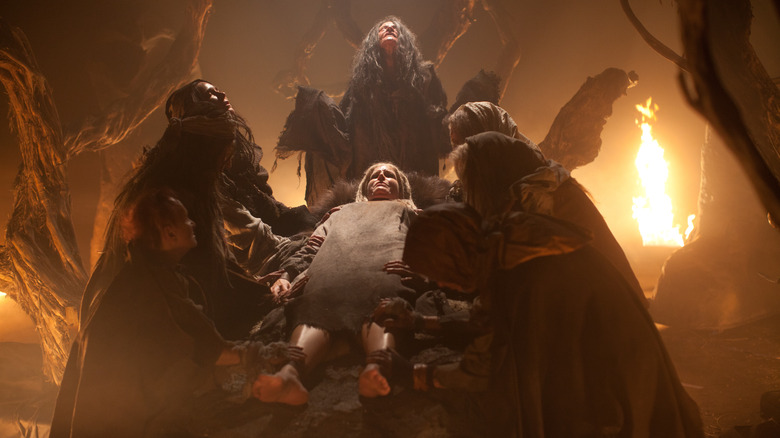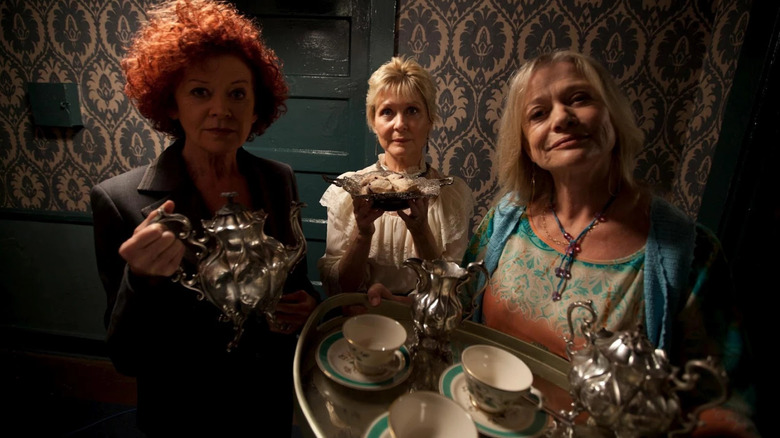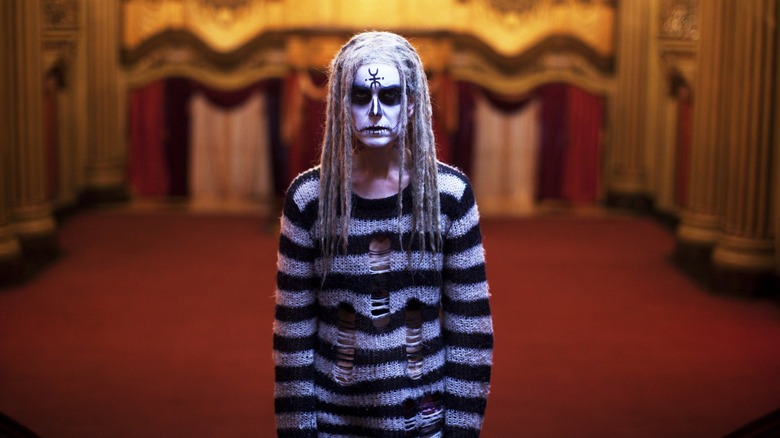Rob Zombie Had To Look Across The Pond For His Lords Of Salem Inspiration
Rob Zombie's 2012 film "The Lords of Salem" may be the filmmaker's best. In it, Sheri Moon plays Heidi, a woman living in Salem, MA, and recovering from drug addiction. She works as a soft-spoken DJ at the local radio station with Ken Foree and Jeff Daniel Phillips. When they play a mysterious rock record on their show — a record that only plays three scary, deep notes over and over — it awakens something inside Heidi. She begins having surreal visions of Satan. The visions are also, perhaps, being encouraged by a trio of women (Dee Wallace, Patricia Quinn, Judy Geeson) who regularly drink wine and converse loudly in her apartment building.
Eventually, it will be revealed that the record was a tool by the town's local Satanists (!) used to hypnotize the town's women into remembering their former lives as the woman tortured and killed in Salem generations ago. Satan, then, becomes a tool for feminist vengeance. "The Lords of Salem" is intense and thoughtful and weirdly mellow for a Rob Zombie movie. There are multiple scenes of people in their 50s and 60s just hanging out and talking. It's strangely warm for a film about Satanism, the Salem Witch trials, and intergenerational vengeance.
Zombie, when he began to research the history of Salem, found that the Salem Witch Trials, while a horrendous shame in American history, didn't quite have the "horror movie" qualities he was looking for. In a 2013 interview with Complex, he explained that he had to look to the Witch Trials in Europe for the really gory stuff.
The European Witch Trials
In infamous Salem Witch Trials, as any American junior high student can tell you, took place in 1692 and 1693 and involved crazed Christian paranoia about Satanism and black magic. Many people, most of them young women, were put on trial for the crime of practicing witchcraft. Arguing against an alliance with the Dark One was nigh impossible given the parameters of the kangaroo court — how does one prove they're not a witch? — and over 200 people were put on the stand with the intent of ousting them from the community for one reason or another. 20 people were executed by hanging. The details of the case can easily be found in various online historical resources, and the widely assigned 1953 Arthur Miller play "The Crucible" details the Trials as a parallel to McCarthy-inspired Communist paranoia in the American government at the time.
Zombie understood the real-life horror of the case, but when making a horror movie, a sad story of a paranoid theocracy executing teenage girls by hanging didn't have the exploitation "zing" he sought. Luckily, 14th-century European witch paranoia could provide. Zombie said:
"Like a lot of people, I knew about the Salem Witch Trials but I'd never actually researched it before. So when I started reading up on them, I learned how few people had actually died, and how conventionally it had all gone down. They would basically take people out and hang them; it was a horrible event, of course, but it wasn't nearly as crazy as I'd thought. A lot of what had informed me early on was the European stuff, where they'd killed thousands and thousands in whatever crazy ways they could think of, from spiked chairs to iron masks to tarring and feathering."
Medieval torture devices
Zombie, it seemed, conflated the Salem Witch Trials with a more widespread "hunting" of witches in Europe going back to the 1300s. According to the 1980 essay "The European Witch Craze of the 14th to 17th Centuries: A Sociologist's Perspective" by Nachman Ben-Yehuda, anywhere from 200,000 to 500,000 people were executed for the crime of witchcraft, at least 85% of which were women. A lot of the witch craze was an outcropping of the Spanish Inquisition (instigated in the late 1490s and early 1500s), as well as general trends toward misogyny and antisemitism. In 14th-century Europe, torture and execution devices were far more, uh, creative than mere a gallows, and many found themselves boiled in oil, sawn in half, or merely crucified. Some of the other medieval European torture devices can be found listed online, eager to be studied by people with strong constitutions.
It was those devices that inflamed Zombie's imagination as a horror filmmaker. In researching Salem, Zombie was surprised to learn that medieval torture devices were not on hand in America. As such, he deliberately fudged history in order to get the deliciously nasty visuals he sought. He admits his ignorance, saying:
"That was what I had in my mind to begin with, so it turned out that I was misinformed about the Salem Witch Trials. When I really started getting into this film, I thought, well, I can just go with the European stuff. I knew that visually, as a movie, it would work much better with the European angle."
"The Lords of Salem," while drawing a few brief images of medieval European torture devices, is in fact a modern story about recovery, misogyny, and righteous, vengeful indignation. It's more thoughtful than exploitative.
Watch it on the Roku Channel or Tubi.


